nmp
Member
Earlier I outlined a process by which a silver based prins such as salt, POP, VDB, kallitypes etc including traditional silver gelatin can be toned in cyanotype like chemistry without losing the underlying silver image.
https://www.photrio.com/forum/threads/van-dyke-over-cyanotype.177290/page-2 (msg # 27)
A number of efforts have been made over the years to combine cyanotype with other alternative processes. One of my favorite is cyanotpye over platinum/palladium. There is some great work out there with this combination - the good thing about this is that the underlying platinum/palladium image is inert to the cyanotype process so you get two superimposed layers, one atop the other. The same is not true with a silver image like that of a salt print or a VDB print as the first layer. The obvious problem here is the ferricyanide in the cyanotype chemistry bleaches the silver, so once you get the blue layer, you have to do something to bring back the missing silver layer. Bronson Dugnutt described his process where he used conventional silver gelatin developer such as HC-110 to redevelop silver:
https://www.photrio.com/forum/threads/van-dyke-over-cyanotype.177290/page-2 (msg #26)
Most conventional develpers are alkaline which means now the Prussian blue is bleached.
Printing cyanotype first and then VDB is no better with some funky results (unless that is what you are looking for):
https://www.alternativephotography.com/vandyke-over-cyanotype-special-effects/
The question is: Instead of coating two sensitizers and two expose, develop, etc., why not simply use the very well established blue-toning procedure that gives the end result that is chemically identical to the cyanotype i.e. Prussian blue (unless there is a creative need to selectively tone some parts of the image and not others by use of different negative for each layer - something this approach will not do.)
In the traditional blue toning, silver is oxidized with potassium ferricyanide to form insoluble silver ferrocyanide and potassium ferrocyanide. The latter then combined with a ferric salt in the toner to form Prussian blue.
4Ag + 4K3Fe(CN)6 ---> Ag4Fe(CN)6 (s) + 3K4Fe(CN)6
3K4Fe(CN)6+ 4FeX3 ---> Fe4[Fe(CN)6]3 (s) + KX
Silver ferrocyanide is white so the resulting image is simply made of Prussian blue.
If we have KBr in the toning medium, we will have:
Ag4Fe(CN)6 + 4KBr ---> 4AgBr + K4Fe(CN)6
Potassium ferrocyanide generated this way will react with ferric salt to form more Prussian blue.
Over all, the brominating bleach + blue toning reaction is:
3Ag + 3K3Fe(CN)6+ 3KBr + 4FeX3 ---> Fe4[Fe(CN)6]3 + 3AgBr + 12KX
Every 3 silver atoms result into 1 Prussian blue and 3 silver bromide molecules.
The image turns blue (See A in the attachment.)

Now to convert the silver bromide back to image forming silver, either it can be converted to silver sulfide using an indirect toner such as one containing sodium sulfide or reduced to silver using a developer. I chose the latter with a simple ascorbic acid (vitamin C) developer with sodium carbonate as the alkali, primarily as I have it on hand and its easy to deal with.
Before reducing silver bromide, I did a separate sodium carbonate bleach to convert first the Prussian blue to ferric hydroxide which is yellowish (B on the attachement.)
Next step is to blanket expose in daylight and develop with ascorbic acid / carbonate developer bringing back the original silver image, which is now accompanied by a weak yellowish ferric hydroxide (C on the attachement.)
Finally, regenerate Prussian blue from ferric hydroxide by treating with acidic ferric ferrOcyanide and you end up with green tone - combination of reddish brown and blue (D on the attachement.)
I will give starter recipes and conditions with a real image print in an another post.
Comments welcome....
https://www.photrio.com/forum/threads/van-dyke-over-cyanotype.177290/page-2 (msg # 27)
A number of efforts have been made over the years to combine cyanotype with other alternative processes. One of my favorite is cyanotpye over platinum/palladium. There is some great work out there with this combination - the good thing about this is that the underlying platinum/palladium image is inert to the cyanotype process so you get two superimposed layers, one atop the other. The same is not true with a silver image like that of a salt print or a VDB print as the first layer. The obvious problem here is the ferricyanide in the cyanotype chemistry bleaches the silver, so once you get the blue layer, you have to do something to bring back the missing silver layer. Bronson Dugnutt described his process where he used conventional silver gelatin developer such as HC-110 to redevelop silver:
https://www.photrio.com/forum/threads/van-dyke-over-cyanotype.177290/page-2 (msg #26)
Most conventional develpers are alkaline which means now the Prussian blue is bleached.
Printing cyanotype first and then VDB is no better with some funky results (unless that is what you are looking for):
https://www.alternativephotography.com/vandyke-over-cyanotype-special-effects/
The question is: Instead of coating two sensitizers and two expose, develop, etc., why not simply use the very well established blue-toning procedure that gives the end result that is chemically identical to the cyanotype i.e. Prussian blue (unless there is a creative need to selectively tone some parts of the image and not others by use of different negative for each layer - something this approach will not do.)
In the traditional blue toning, silver is oxidized with potassium ferricyanide to form insoluble silver ferrocyanide and potassium ferrocyanide. The latter then combined with a ferric salt in the toner to form Prussian blue.
4Ag + 4K3Fe(CN)6 ---> Ag4Fe(CN)6 (s) + 3K4Fe(CN)6
3K4Fe(CN)6+ 4FeX3 ---> Fe4[Fe(CN)6]3 (s) + KX
Silver ferrocyanide is white so the resulting image is simply made of Prussian blue.
If we have KBr in the toning medium, we will have:
Ag4Fe(CN)6 + 4KBr ---> 4AgBr + K4Fe(CN)6
Potassium ferrocyanide generated this way will react with ferric salt to form more Prussian blue.
Over all, the brominating bleach + blue toning reaction is:
3Ag + 3K3Fe(CN)6+ 3KBr + 4FeX3 ---> Fe4[Fe(CN)6]3 + 3AgBr + 12KX
Every 3 silver atoms result into 1 Prussian blue and 3 silver bromide molecules.
The image turns blue (See A in the attachment.)
Now to convert the silver bromide back to image forming silver, either it can be converted to silver sulfide using an indirect toner such as one containing sodium sulfide or reduced to silver using a developer. I chose the latter with a simple ascorbic acid (vitamin C) developer with sodium carbonate as the alkali, primarily as I have it on hand and its easy to deal with.
Before reducing silver bromide, I did a separate sodium carbonate bleach to convert first the Prussian blue to ferric hydroxide which is yellowish (B on the attachement.)
Next step is to blanket expose in daylight and develop with ascorbic acid / carbonate developer bringing back the original silver image, which is now accompanied by a weak yellowish ferric hydroxide (C on the attachement.)
Finally, regenerate Prussian blue from ferric hydroxide by treating with acidic ferric ferrOcyanide and you end up with green tone - combination of reddish brown and blue (D on the attachement.)
I will give starter recipes and conditions with a real image print in an another post.
Comments welcome....
Last edited:


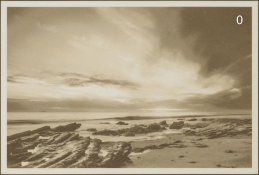
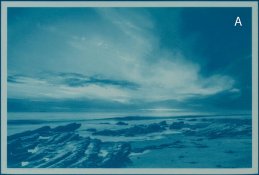
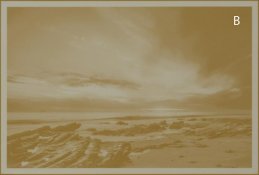
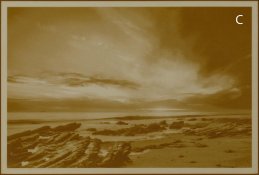
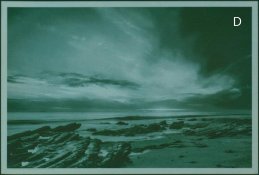
 But it is nice to have it in the repertoire just in case it suits the subject.
But it is nice to have it in the repertoire just in case it suits the subject.